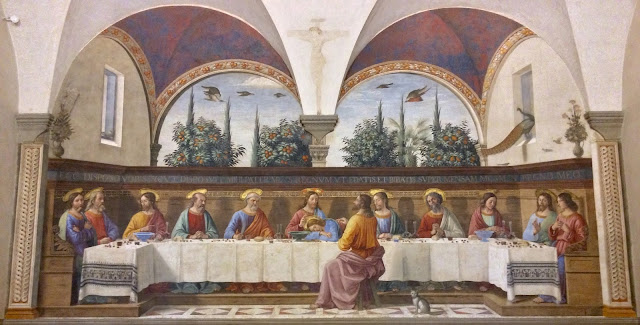One of Dominicans who lived at San Marco was Girolamo Savonarola. He was a Dominican friar, the Prior of the San Marco Convent and, for a while, the de facto ruler of Florence.
Depending on what you read and who is giving an opinion, Savonarola was either saint-like or mentally disturbed.
Here is some background. Girolamo Savonarola was born in Ferrara, Italy, in 1452. He was educated and, before joining the Dominicans, he wrote about the corrupted state of the world and the church, including the Papacy in Rome. In 1475, he joined the Dominican order, the Order of Preachers, in Bologna and was ordained a priest in 1476. He continued his education and writing, while teaching and preaching. Over the course of 14 years, he traveled in northern Italy, teaching and preaching in different convents, including a time in San Marco. He preached against corruption in the world and the church and managed to alienate his superiors in the order. During this period, Savonarola later said he received religious revelations about .
Savonarola found a kindred spirit in Florence (the philosopher Giovanni Pico della Mirandola) who arranged for Lorenzo d'Medici to have Savonarola assigned to San Marco in 1490. That was the beginning of Savonarola's end. He continued preaching about the corruption of the world and the church and the coming of new world. He preached to larger and larger crowds, starting in the San Marco church, moving to the square in front of the church and then to the cathedral which could hold up to 30,000 people. Apparently, he was a gifted preacher who could talk for hours. He attracted a large number of followers whom others derisively dubbed the "piagioni", or wailers.
In 1492, Lorenzo d'Medici died and was succeeded by first son, Piero, a much weaker leader. By 1494, Florence was ready for a change. Savonarola had prophesied about an invader from the north who would help purify Florence and usher in a new age. In late 1494, King Charles VIII of France invaded Italy in an effort to occupy and rule Naples. As Charles VIII's army approached Florence, the people of Florence ousted Piero d'Medici and Savonarola arranged to pay off Charles VIII. The king's army left Florence and headed south to Naples, leaving Florence to Savonarola ad his many followers.
With the ouster and exile of the Medici family, Savonraola, who could not hold public office, became the de facto ruler of Florence. His followers held key posts in the government and took their cues from Savonarola.
For four years, Savonarola ruled Florence, preaching purity and renewal while continuing to stridently rail against worldly vice and the corrupt church. During this period, Savonrola arranged for bonfires of the vanities--public burning of secular objects, including non-religious paintings and other worldly valuables.
After 4 fours of secular rule, in 1498, Savonarola's reign ended. He had refused the Pope's command to join an alliance against the French and also to come to Rome. As a result, the Pope excommunicated Savonarola and banned him from preaching. For a while, Savonarola obeyed the ban but resumed preaching.
Savonarola had indicated he was on a mission from god, having had visions and performed miracles. A rival preacher, a Franciscan, proposed to test Savonarola's divine mission with a trial by fire. The people of Florence wanted to see whether divine intervention would save Savonarola or not. The day of the test arrived. Stalling followed by a downpour led to cancellation of the trial.
Public opinion turned against Savonarola. Shortly after the test, Savonarola was arrested and then tortured. Under torture, he confessed that his visions and prophesies were fabricated.
Savonarola was then condemned to death as a heretic and a schismatic and then hanged and burned in front of the Palazzo Vecchio. His ashes were scattered in the river to prevent veneration of his remains.
Savonarola's legacy is mixed. Some members of the Dominican order have venerated Savonarola and they studied and followed some of his teachings, as have some religious and political figures and philosophers. Others dismiss Savonarola. Putting aside Savonarola's mixed legacy, he was a powerful religious and political force during the Renaissance in Florence.
 |
| A portrait of Savonarola (with some dude reflected in the glass) |
 |
| Savonarola's robe on display in the San Marco convent |
 |
| In the San Marco convent, a plaque marks the place where Savonarola was arrested. |
 |
| A painting depicting Savonarola's end in front of the Palazzo Vecchio in Florence. |
 |
| A plaque marks the approximate spot where Savonarola met his end. |
 |
| A bell on display in the San Marco convent. The bell hung in the San Marco bell tower and was rung continuously when Savonarola was arrested. The continuous ringing was a call to his followers, the piagnioni (or wailers), to come and defend the convent against attacks by anti-Savonarola factions. Later, once Savonarola was convicted, the anti-Savonarola factions took the bell from the tower and dragged it through the streets of Florence while flogging it. (The description below explains more about the bell and its history.) |
 |
| Not far from San Marco is a lovely square dedicated to Savonarola, Piazza Savonarola. |
 |
| A statue of Savonarola in the middle of Piazza Savonarola |































































